Let’s take an example and try to understand if the key results you’ve come up with are really the right ones.
In this example, we are trying to reduce the page load time of a web page, as reported by Google. As you may know, “page load time” is one of the key indicators of high-quality websites from an SEO standpoint. Apart from SEO considerations, page loading time is a very important aspect from a UX standpoint as well.
Once this is decided as an important enough problem to be addressed, engineering and the website teams work together and come back with 5 key results. Let’s take a look at this particular OKR and see what is wrong with this and how we can fix it.
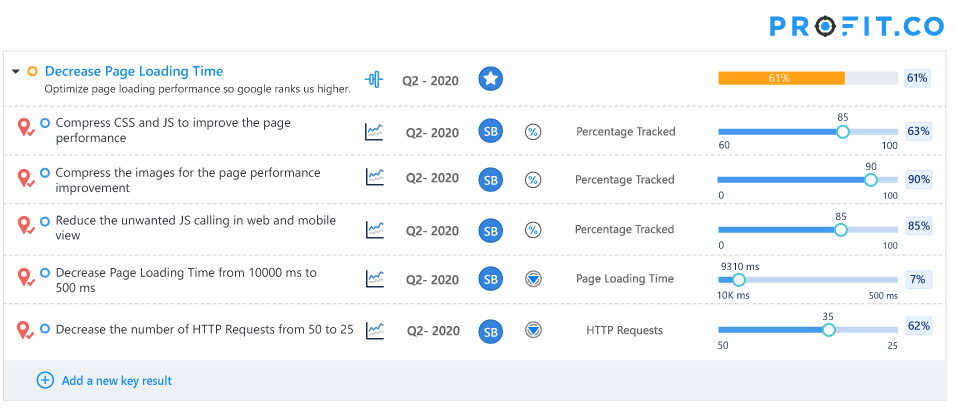
Out of the 5 key results, four are reflective of the work they are trying to do:
- KR1: We have to compress the CSS and JavaScript files to improve the page performance
- KR2: We need to compress the images for page performance
- KR3: Remove unwanted JavaScript files
- KR4: Decrease page loading time from 10,000 milliseconds to 500 milliseconds, basically from 10 seconds to .5 seconds.
- KR5: Decrease the number of HTTP requests from 50 to 25 on the page.
And finally, they also had this key result, which is the topical key result here, which basically states the objective and puts the target numbers on those.
People approved this and then they started executing on it.
Three weeks into the cycle you see the progress reported against the KRs. If you observe carefully, you can see that there is a big anomaly. What is the anomaly? You see that key results KR1, KR2, KR3, and KR5 are all progressing really well. 63%, 90%, 85% and 62% progress on those respectively. And they all seem to be on track as well. Very good. Right? But if you see the fourth key result KR4, which is the topical key result here, it is sitting at 7%. So clearly there is a problem. The problem is that you’re not really achieving the bottom line impact that you were planning to achieve by executing the other four key results. That’s really what this OKR panel is highlighting in a very nice way.
This is great learning. Obviously something went wrong somewhere and detecting this anomaly three weeks into the quarter is a lot better than passing the entire quarter by and then realizing, “Hey, we did all of that, but then it didn’t matter. Nothing happened. Or very little happened.” While it doesn’t make sense that we wasted so much time on the four KRs, it’s a lot better to detect early to put some course corrections in place. So from that standpoint, we have to thank the process of OKRs, which helps us with a single clear view of what is happening as well as the frequent tracking or check-ins that we talk about, which helped us to spot the problem.
Now let’s see why this problem even occurs in the first place. So as you can see from this two by two matrix, we have two axes here, prioritization of action items on the left and completeness of analysis or action plans on the bottom axis, X axis.
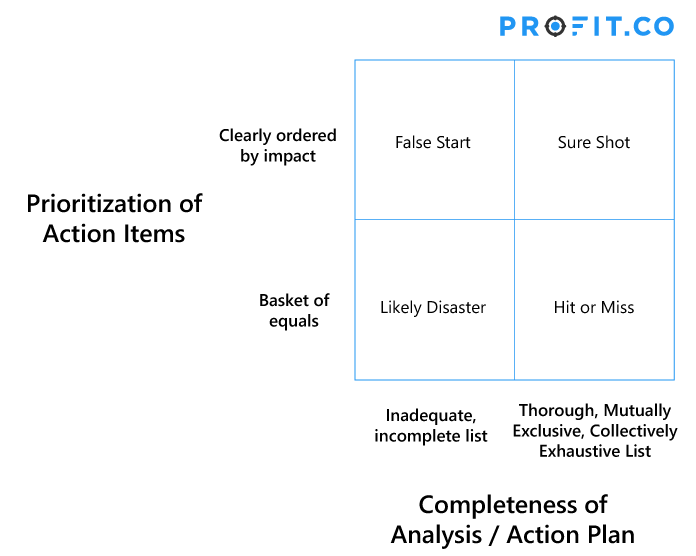
So on each axis, we have two buckets. On the X axis, completeness of action analysis action plans, we have:
- Inadequate/incomplete list on one end and,
- Thorough MECE list or mutually exclusive and collectively exhaustive list on the other end.
On the Y axis, prioritization of action items we have:
- Basket of equals, which means the list of actions has not been prioritized properly and,
- Clearly ordered by the impact on the top.
So now if you start with an inadequate or incomplete list and also don’t prioritize and treat your actions as a basket of equals, you have a disaster waiting to happen. Unless you are extremely lucky, you’re not going to achieve your key result. Its plain and simple. And our current situation is sort of like this.
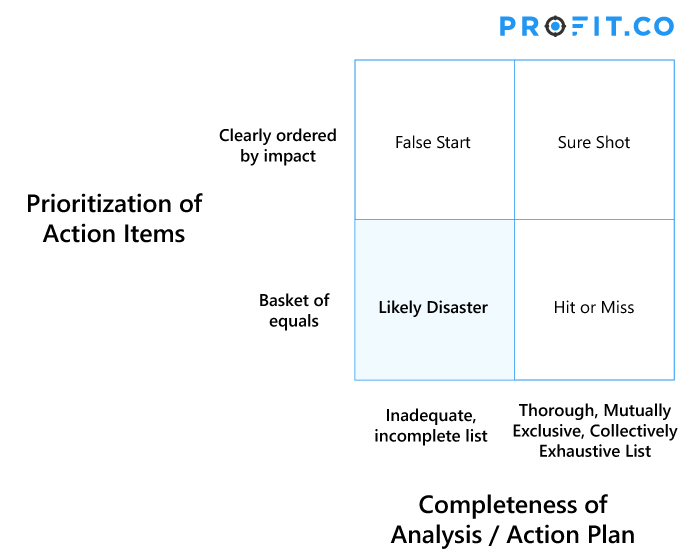
Then let’s say you have an inadequate, incomplete list, but then you try to order it by impact and start. You still have a problem, but you may get some benefit, but it’s so clearly a false start.
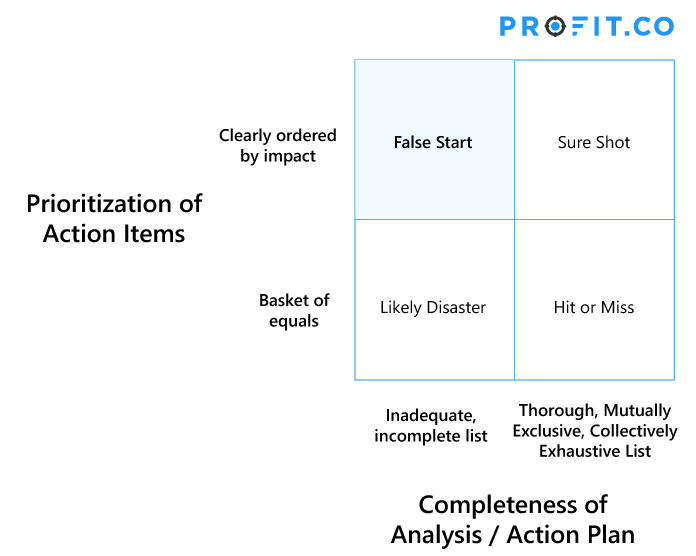
Now let’s go walk to the right side. And if you look at the bottom half of the mutually exclusive, collectively exhaustive (MECE) list, you have a comprehensive list, but you have not prioritized them properly. It will still be a hit or miss because depending on what you pick, you may not really get the full benefit.
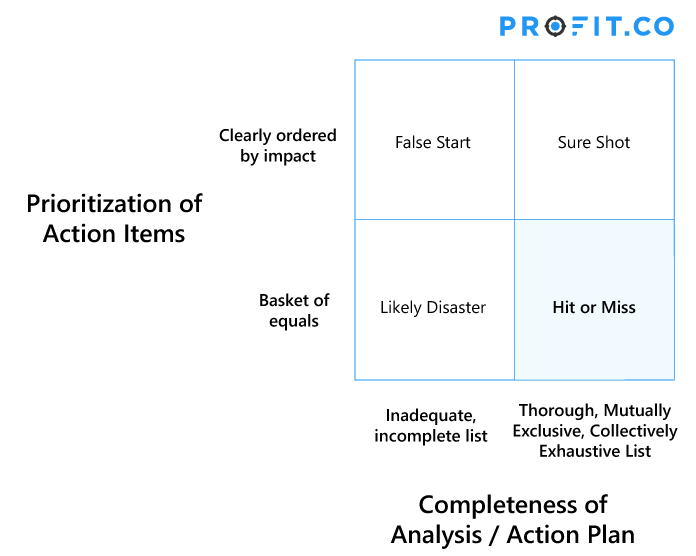
Finally, you land on the 4th quadrant. So a thorough MECE list, which is clearly ordered by impact, will give you a sure shot at achieving the objective you set out to achieve.
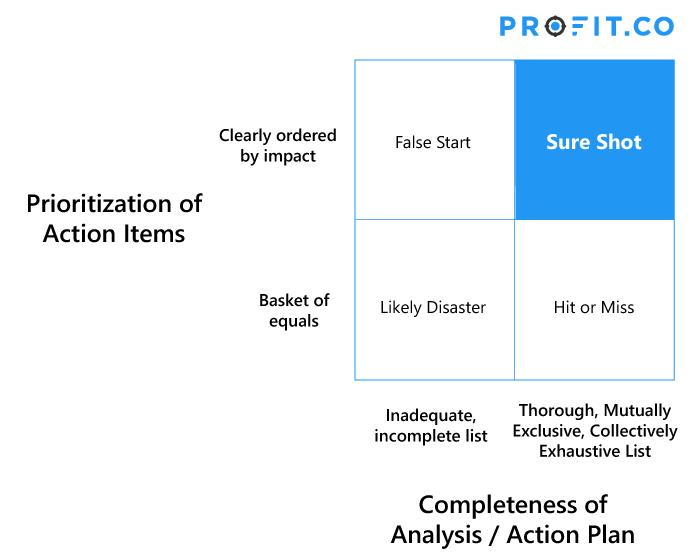
So going back to our example now we know that this suffers from an inadequate list problem for sure, because they’ve made considerably good progress on all the four other items. And still there is no impact to the KR and KPI that matters. So, you know that this is an inadequate list for sure. So what this warrants is, you have to go back and look for other things that need to be done, that will actually give you an impact to the bottom line. Prioritization doesn’t seem to be a problem here, because the list is so small. But it could be a problem in other situations. We don’t know. It could be a problem. Once you have the full list, you’ll know if you have a prioritization problem. The first order of priority is to get the full list though.
